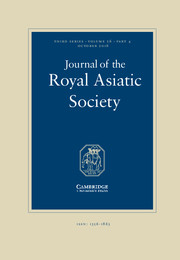
AYANGIL, Ruhi. 2008. “Western Notation in Turkish Music.” Journal of the Royal Asiatic Society. 18(4): 401–447.
ABSTRACT
The adoption of western notation (which is an example of graphic notation) as the “official system” in Turkey dates from after 1828. Sultan Mahmud II (reigned 1808–1839) abolished the Janissary force in 1826 and with it the musical unit of that army, it was a band for wind and percussion instruments (Mehterhâne-i Hümâyûn). He then organised his new army on western lines and thus introduced an institution of western origin, the military band, as the musical unit of his modern army. This new institution, which was European in its music system, instruments, repertoire and first and foremost its methods of education, was formed under the name Muzika-i Hümâyûn (the royal military band). Professional musicians were invited from Europe to participate and, with the foundation of Muzika-i Hümâyûn in 1827, the most far-reaching change in Turkish musical history took place. It was an outstanding manifestation of westernisation which necessarily made a deep impact on both the Turkish makam (modal) music system and the existence and the behaviour of the musicians who produced and performed it. The domination of makam music and its masters in court circles and their claim to be the sole and absolute system of taste was undermined, although the appreciation and respect of certain sultans and bureaucrats continued on a personal level. From that date on, a duality, an East-West dichotomy (the effects of which can still be seen), overtook the cultural sphere of which music was a part. Within this dichotomy, tonal polyphonic music of the West began to make its influence felt at least as much as, if not more than, makam based Turkish music both within the state framework and in the society at large. These dual concepts were referred to as Alla Turca and Alla Franga. While Alla Franga (alafranga in common parlance) came to symbolise modernity, change and the new life style, Alla Turca (alaturka in common parlance) became a manifestation of being archaic and conservative and of having a blind commitment to tradition and an under-developed taste (even no taste at all). Within this series of dichotomies, which took hold of every area of life (from literature to fashion also, eating habits, systems of beliefs, and education as well as government) makam based Turkish music received a large share of “cultural negation” with the judgement that it did not even have a decent notation system. It became marginalised and restricted to a narrow social group deeply and passionately devoted to it. Even during this process, makam music developed a dynamic of self-protection against “cultural negation” with its composers, theorists, publishers, performers and listening public. Makam music composers and performers learnt western notation, they wrote pieces down and deciphered music from that notation; a system of education based on modern methods developed while still preserving meşk (the traditional oral teaching method of Turkish music). These efforts were driven by the ‘ideal’ of transforming makam music, which was claimed to be archaic due to its monodic structure, into a polyphonic music. The musicians who knew western notation (such as Melekzet Efendi, Leon [Hancıyan] Efendi, etc.) were paid great amounts of money in order to record the works of the old masters in western notation and compile them, along with new compositions, into extensive note-collections (such as Muzika-i Hümâyûn Kumandanı [the commander of the royal military band] Necîp Paşa Collection and the Pertev Paşa Collection, etc.). Works were also published in note editions (such as Mâlûmat [literally meaning knowledge], Müntehâbât [literally meaning selections], Ûdî [lute-player] Arşak editions, etc.). Moreover, educational guides devoted to teaching makam theory and solmisation (such as Tanbûrî Cemîl Bey’s Rehber-i Mûsikî [The Music Guide], Muallim [teacher] İsmail Hakkı Bey’s Mahzen-i Esrâr-ı Mûsikî [The Cellar of the Secrets of Music], Muallim Kâzım Bey’s Mûsikî Nazariyâtı [Music Theory], etc.) and the first methods for learning the instruments of makam music (such as Ûdî Salâhî Bey’s Ud metodu [Lute Method], Seyyid Abdülkaadir Bey’s Usûl-i Ta’lîm-i Keman [Method for Practising Violin, etc.], modelled on their European counterparts, were beginning to be published.